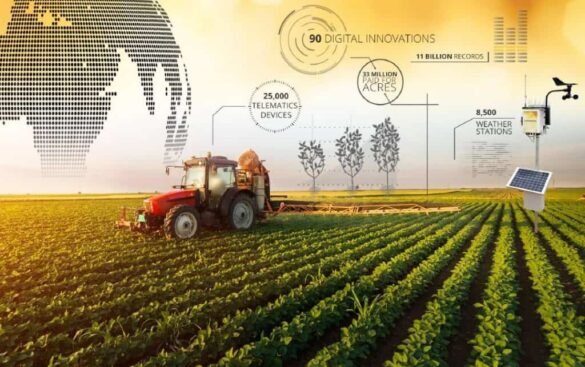Table of Contents
Agricultural science is the study of plants, animals and other natural resources used to produce food for humans. It combines exact and biological sciences with economics and social sciences.
Agricultural science can teach students about how much work goes into producing a single bite of food. This can make them less likely to waste food and encourage a sustainable lifestyle.
The Evolution of Agricultural Science
People have been growing food to sustain themselves for thousands of years, but agricultural science has only recently become a scientific discipline. It combines many disciplines of biology, chemistry and genetics to improve crop production for both farmers and consumers while reducing potential environmental impacts.
Agriculture is a broad field that includes the production of grasses, grains, seeds, fruits and vegetables. It also encompasses the production of fibers for human and animal use, including hemp, flax, cotton and wool from sheep, llama, alpaca and yak. These fibers are gathered from the animals, rather than grown purposefully, and include the popular qiviut from musk ox, used by Inuit and Native Alaskans.
The development of agriculture changed the Earth as a whole by creating a more stable environment for humans and other organisms to grow and thrive. This was a slow process, and many events contributed to its evolution.
Women were instrumental in this transformation, as they had generational experience collecting wild foods, such as berries, roots and tubers. In addition, their eyesight and motor skills are sharper than men’s.
Some of the earliest forms of agriculture focused on producing crops that could be eaten directly by people, such as potatoes, cassava and yams. These plants could be propagated simply by burying a small part in the ground and thus did not require extensive knowledge of plant life cycles.
Crop Science
The practical side of agricultural science focuses on the fairly complicated processes plants go through to produce safe, edible chow for the people of Planet Earth—from a shiny red apple to a spongy yellow Twinkie. Agricultural scientists study things like soil management, sustainable cropping systems and seed science.
One of the main goals of the modern field of agronomy is to increase food production. As agricultural scientists experiment with new tools and resources, crop yields per acre have increased dramatically. This has had a positive impact on world economies, which are now more interconnected and dependent on each other than ever before.
In addition to producing food for humans, some crops are also used as animal feed. For example, the husks of pineapples are used for animal feed as are the roots and leaves of sugar beets. Some food grown for human consumption, such as corn and brewer’s grains, are also used to make biofuels.
Besides improving crop yields, agronomists also focus on the quality of food produced. For instance, they might create genes that would give fruit a sweeter taste or make it grow bigger or juicier.
An important aspect of an agriculture major’s education is the opportunity to gain work experience through internships and other off-campus opportunities. Many colleges have career placement offices to help students find jobs in the agriculture industry.
Animal Science
Agricultural scientists investigate animal biology to create a better understanding of food animals and help people use them as productive sources of meat, dairy, fur, eggs and other vital commodities. This work includes research on genetics, nutrition, breeding and physiology. It also addresses the environmental and ethological needs of food animals, which are key to the sustainable utilization of animal resources.
A graduate with a bachelor’s degree in this field may find employment with the government, private industries or at universities. A few options include animal and crop research with laboratories, feed companies, veterinary hospitals and consulting firms. Some graduates also find success as livestock producers, farm managers or in agribusiness management.
The agriculture industry is constantly changing to meet consumer demands and the challenges of a finite earth. Agricultural scientists are trained to identify opportunities and devise innovative solutions to address complex agricultural issues such as increasing food production with less land, adapting to climate change, and reducing potential impact on the environment.
Having a broad education in the full spectrum of agriculture gives our students a unique advantage. Whether it’s hands-on work with livestock and plants, time in the field as an intern or working directly with local farmers on a senior project, our graduates have a laser-focus on a career that matches their skills, passions and interests.
Biotechnology
Many people use the term biotechnology to describe the latest developments in genetic engineering, cloning and other technologies that manipulate living organisms. However, these techniques are merely the latest stage in humankind’s long history of using living organisms to solve problems and improve its way of life. People began changing the genetic makeup of crops and animals through selective breeding as early as 10,000 years ago.
Agricultural biotechnology is the latest application of these technologies, and offers great potential to help feed the world’s growing population while reducing the environmental footprint of agriculture. Some of the first discoveries in agricultural biotechnology were made with microorganisms like bacteria and viruses, which are easier to work with in the laboratory. For example, researchers used biotechnology to develop a bacterium (Pseudomonas syringae) that can prevent frost damage to plants by inhibiting the formation of ice crystals in plant cells.
Other innovations include developing strains of crops with improved yields and quality traits. Yield traits aim to reduce the amount of pesticides needed for crop protection while increasing the ability to grow crops in a wider variety of climate conditions. Crops with quality traits are aimed at improving food production, processing and storage, or to eliminate toxins or allergens from crops. For example, a gene encoding for beta carotene formation has been inserted into rice to aid in the fight against vitamin A deficiency.

